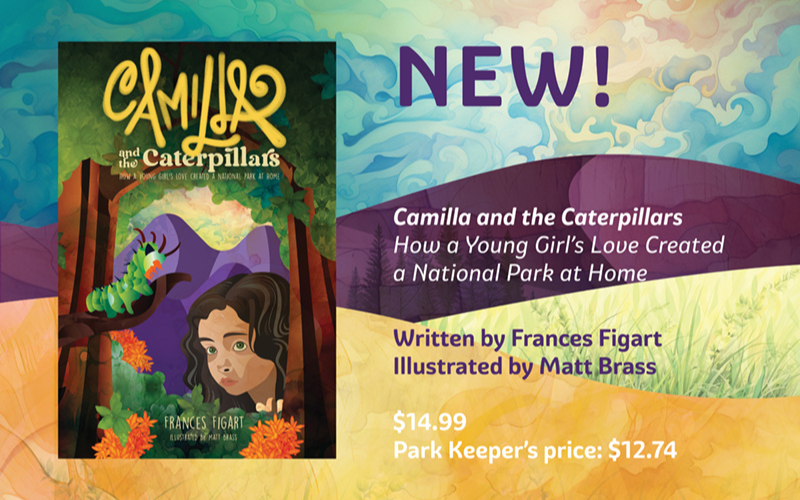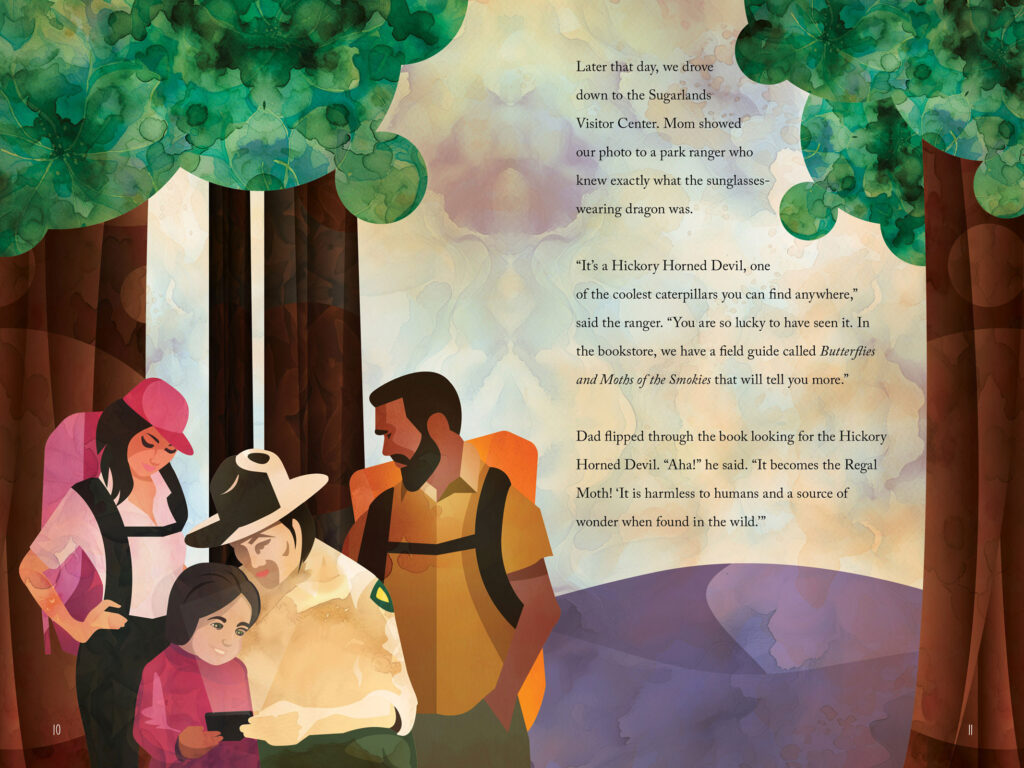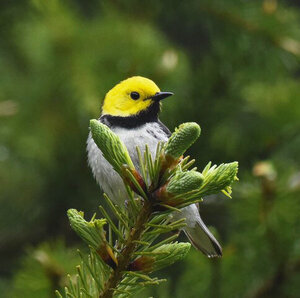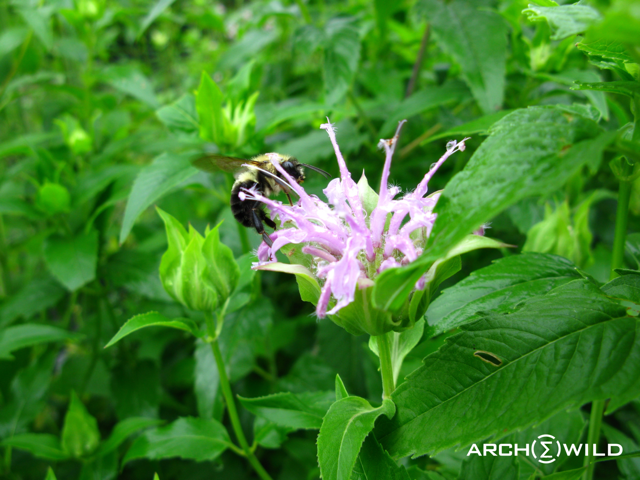A New Chapter for Nature, Collaboration, and Native Plants
At Homegrown National Park® (HNP), we believe in the power of individual action to transform the world, one yard at a time. That’s why we were thrilled to collaborate on the message behind Camilla and the Caterpillars, a new children’s chapter book by Frances Figart, beautifully illustrated by Matt Brass.
This delightful story carries a powerful message that resonates deeply with our mission: the importance of native plants in fostering biodiversity and the wonders of nature. Through Camilla’s journey, readers are invited to explore how simple choices—like replacing non-native plants with native species—can create thriving ecosystems right in their own backyards.


The Magic of Discovery
Camilla’s first encounter with a caterpillar was nothing short of magical. Mistaking the creature for something fantastical—a dragon in sunglasses—Camilla soon learns that the creature is actually a hickory horned devil, a large caterpillar that eventually transforms into a regal moth. For Camilla, this discovery is not a letdown but the beginning of a lifelong fascination with the natural world, particularly with caterpillars and their transformation into moths and butterflies.
The story of Camilla and the Caterpillars begins with this enchanting moment, setting the stage for a tale that encourages young readers to explore their own connections with nature. Frances Figart, who also serves as creative services director at Smokies Life, hopes that Camilla’s curiosity and passion will ignite a similar spark in children, showing them that they, too, can shape the future of the planet.
The Invasion of Non-Native Plants
As Camilla grows, her family moves from a city apartment to a suburban home with a yard. However, her excitement fades when she realizes that despite the space, there are no caterpillars, no bees, and no signs of wildlife. The yard is overrun with invasive plants, devoid of the native species that support vibrant ecosystems.
This moment mirrors a challenge faced by many families and individuals across the country: the dominance of invasive species in our landscapes. Whether it's English ivy, Japanese knotweed, or Bradford pear trees, non-native plants often take over our yards, choking out the plants that local wildlife depends on for food and shelter.
But just as Camilla's story takes a hopeful turn, so too can our real-world landscapes. When her family friend Carlos, who is pursuing a PhD in "nature," introduces the family to the concept of planting native species, they embark on a journey to transform their barren yard into a haven for wildlife.
A Movement for Change
Through the process of removing invasive species and planting native ones, Camilla's yard soon becomes home to an array of creatures—caterpillars, bees, birds, bobcats, and more. The story reflects the core mission of Homegrown National Park: encouraging people to convert their lawns into biodiverse landscapes where nature can thrive.
Native plants play a critical role in supporting ecosystems. Unlike ornamental plants that may look beautiful but offer little to no food for insects or birds, native plants provide the nutrients and habitat that local species need to survive. Doug Tallamy, renowned ecologist and co-founder of HNP, has long championed the idea of transforming America’s lawns into native habitats. His research shows that converting just half of the 40 million acres of lawn in the U.S. to native habitat would create an area larger than several national parks combined, providing essential support to dwindling wildlife populations.
Tallamy’s work, which deeply inspired Figart while writing Camilla and the Caterpillars, highlights how important it is for homeowners to rethink their yards—not just as spaces for recreation, but as vital pieces of the larger environmental puzzle. This collaboration between Figart, Tallamy, and Homegrown National Park weaves together science and storytelling to inspire readers to take action, showing them that small changes in their own backyards can make a big difference.
The Power of Native Plants
In Camilla and the Caterpillars, the transformation of Camilla's yard serves as a metaphor for the broader environmental changes we hope to see through our Homegrown National Park initiative. By choosing to plant native species, Camilla’s family creates a refuge for wildlife in their own backyard. The once-quiet yard, devoid of life, is now alive with the hum of bees, the flutter of moths and butterflies, and the presence of larger animals like owls and bobcats.
This transformation mirrors the journey many of our participants experience when they decide to create a Homegrown National Park in their own yard. It’s not just about planting a few flowers; it’s about rebuilding ecosystems and creating spaces where the natural world can flourish. Native plants support pollinators like bees and butterflies, which are essential for a healthy environment. They also provide food and shelter for birds and small mammals, helping to restore the balance of nature that has been disrupted by human development.

A Story That Inspires Action
Figart’s personal experience with native plants was a major influence in writing Camilla and the Caterpillars. When she first purchased her home in Asheville, she discovered her yard was filled with invasive Japanese knotweed. It wasn’t until she met her future husband, who had planted native species on his six-acre property in East Tennessee, that she began to understand the critical role native plants play in supporting wildlife.
Her connection with Tallamy further deepened her understanding. During an interview with him for a project celebrating Discover Life in America’s 25th anniversary, Tallamy shared how he had transformed his own property by planting native species. He revealed that after putting the plants back, his property had become home to 1,199 species of moths—a staggering 44% of the species found in Pennsylvania. This revelation struck a chord with Figart and became a cornerstone of the book’s message: what would happen if everyone put the plants back?
Camilla and the Caterpillars is more than just a story for children—it’s a call to action for families and communities. It shows how even small actions, like planting native species, can have a big impact on local ecosystems. The story reflects the core values of Homegrown National Park, encouraging individuals to become stewards of their own land and create spaces where nature can thrive.
A Visual Journey Through Nature
The illustrations by Matt Brass beautifully capture the magic of Camilla’s world. Brass, who shares a passion for native plants, created a vibrant, colorful world that brings Camilla’s journey to life. His depictions of the native plants and animals in Camilla’s yard are not only visually stunning but also serve as a reminder of what’s possible when we work with nature, not against it.
Brass’s own backyard reflects the values in Camilla and the Caterpillars. Like Camilla’s family, Brass has transformed his yard into a home for wildlife by planting native species. His personal experience with native plants shines through in the book’s illustrations, making the story even more compelling.
Building a Better Future, One Yard at a Time
At HNP, we are proud to support the message of Camilla and the Caterpillars and to collaborate on a project that aligns so perfectly with our mission. The book offers a hopeful vision for the future—one where children and families can make a real difference by simply planting native species in their own backyards.
Camilla’s story reminds us that nature is more amazing than anything we can imagine, and it’s up to us to protect and nurture it. Whether you have a small garden or several acres, you can create a space where wildlife can thrive. Join us at Homegrown National Park and take the first step toward building a better future, one yard at a time.
Images provided by Smokies Life.




